The Height Measurement Devices Market is estimated to be valued at USD 1.4 billion in 2025 and is projected to reach USD 2.6 billion by 2035, registering a compound annual growth rate (CAGR) of 6.5% over the forecast period.
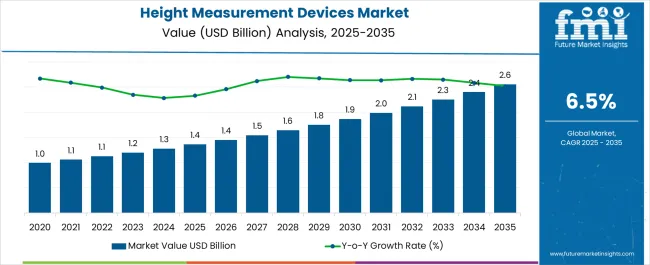
| Metric | Value |
|---|---|
| Height Measurement Devices Market Estimated Value in (2025 E) | USD 1.4 billion |
| Height Measurement Devices Market Forecast Value in (2035 F) | USD 2.6 billion |
| Forecast CAGR (2025 to 2035) | 6.5% |
The Height Measurement Devices market is experiencing significant growth, driven by increasing demand for accurate and efficient anthropometric data collection across healthcare, fitness, and research sectors. Rising awareness of the importance of precise height measurement for health assessments, nutrition monitoring, and medical evaluations is fueling adoption. Advancements in digital technology, including high-resolution sensors, automated measurement systems, and integrated data storage, are enhancing accuracy and usability.
Devices capable of capturing data in real time while reducing human error are gaining preference among hospitals, clinics, and research institutions. The integration of digital measurement devices with health information systems allows for seamless tracking, analysis, and reporting of patient or participant data. Increasing investments in healthcare infrastructure, routine health check-ups, and preventive care programs are further supporting market growth.
Regulatory standards and guidelines emphasizing accuracy and reliability of medical devices are encouraging adoption of certified measurement systems As technology evolves and demand for precise anthropometric data rises globally, the Height Measurement Devices market is expected to witness sustained growth, with innovation and efficiency remaining key drivers.
The height measurement devices market is segmented by product type, technology, age group, end user, and geographic regions. By product type, height measurement devices market is divided into Height Rod and Stadiometer. In terms of technology, height measurement devices market is classified into Digital Height Measurement Devices and Mechanical Height Measurement Devices. Based on age group, height measurement devices market is segmented into Adult Height Measurement Devices and Pediatric Height Measurement Devices. By end user, height measurement devices market is segmented into Hospitals, Clinics, and Others. Regionally, the height measurement devices industry is classified into North America, Latin America, Western Europe, Eastern Europe, Balkan & Baltic Countries, Russia & Belarus, Central Asia, East Asia, South Asia & Pacific, and the Middle East & Africa.
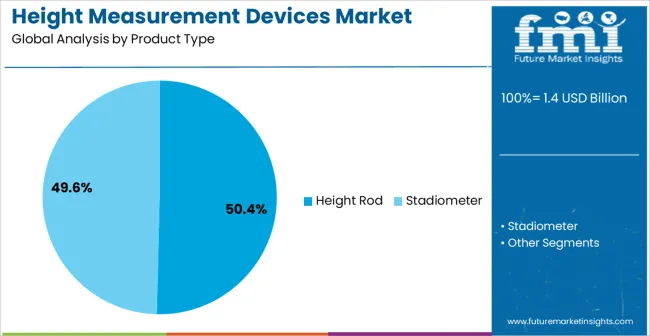
The height rod segment is projected to hold 50.4% of the market revenue in 2025, establishing it as the leading product type. This dominance is being driven by the segment’s simplicity, reliability, and cost-effectiveness in both clinical and field settings. Height rods provide consistent measurements for a wide range of users, requiring minimal training and maintenance, which makes them widely preferred among healthcare providers and fitness facilities.
Integration with digital systems or manual recording options allows for flexibility in various operational contexts. Their durability and ease of use in repeated measurements enhance adoption in hospitals, clinics, and research studies.
Increasing demand for standardized anthropometric assessments across preventive health programs, occupational health screenings, and population studies has further reinforced the segment’s leadership As healthcare organizations prioritize accuracy, reliability, and operational efficiency, height rods are expected to maintain their market dominance, supported by their proven performance and adaptability across diverse applications.
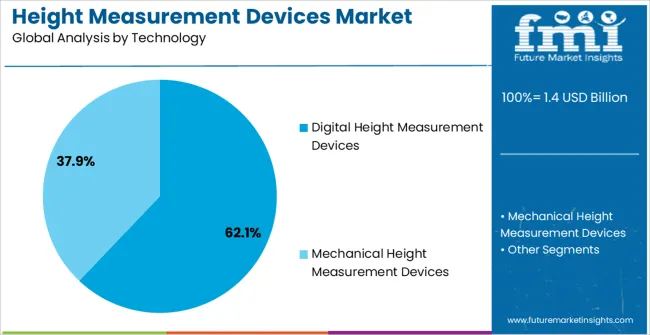
The digital height measurement devices technology segment is anticipated to account for 62.1% of the market revenue in 2025, making it the leading technology type. Growth in this segment is being driven by the need for enhanced accuracy, real-time data collection, and seamless integration with electronic health records. Digital devices reduce human error, ensure repeatable measurements, and enable automated data logging for large-scale health assessments.
Advanced sensor technologies, user-friendly interfaces, and connectivity with software platforms further improve usability and efficiency. Adoption is being reinforced by healthcare institutions, research centers, and wellness facilities seeking reliable and fast measurement solutions.
The ability to integrate digital height measurement devices with analytics platforms for monitoring trends, generating reports, and supporting clinical decision-making strengthens their market position As precision, speed, and operational efficiency become increasingly critical, the digital technology segment is expected to sustain its leadership, supported by continuous innovation in sensor design, connectivity, and smart measurement functionalities.
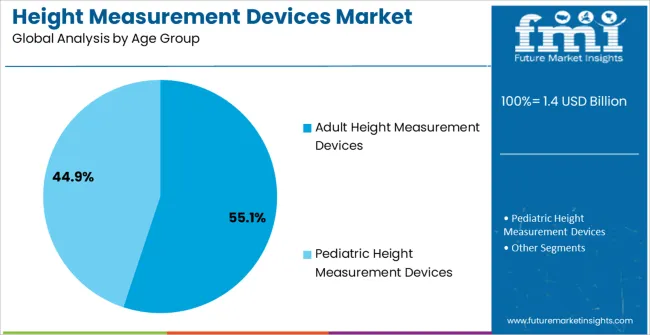
The adult height measurement devices segment is projected to hold 55.1% of the market revenue in 2025, establishing it as the leading age group category. Growth in this segment is driven by the need for accurate anthropometric assessments in adult healthcare, occupational health screenings, and wellness programs. Accurate measurement of adult height is essential for calculating body mass index, monitoring growth trends in late adolescence, and assessing age-related health changes.
Devices tailored for adults are designed to accommodate larger height ranges, provide stability, and ensure user comfort, which enhances their adoption in clinics, hospitals, and fitness centers. Increasing focus on preventive healthcare, workplace wellness initiatives, and adult health monitoring programs has reinforced demand for adult-specific devices.
The integration of these devices with digital systems allows for precise data collection, trend analysis, and reporting, improving operational efficiency As healthcare providers continue to emphasize accurate and reliable anthropometric measurements, adult height measurement devices are expected to maintain their leading market position, supported by advancements in design, usability, and technology.
Height measurement devices are the professional devices used to measure human height. These devices are available as height rods or stadiometers with mechanical and digital modalities. These are used for convenience and measurement accuracy by professionals for both adults and pediatrics. Height measurement devices are required for routine medical examinations in healthcare facilities and for tracking growth in various fitness centers.
Some of the height measurement devices are standalone products while others are designed to be wall mounted. These devices are easy to transport and install at any place for flexible and rapid application. Height measurement rods are nowadays also attached with weighing scales facilitating weighing and height measurement in one step. These devices need to be calibrated at the beginning and end of each examination day in order to reduce the error rate.
Height measurement can be affected by posture, foot wear, feet and head positioning. Therefore, to ensure correct and uniform measurement of adult height, protocols are need to be followed as mentioned on individual device type.
As height is one of the widely used pointer for assessment of nutritional status and delivers an index of linear skeletal growth, these devices are in great demand for professional grade height measurement with accuracy and convenience.
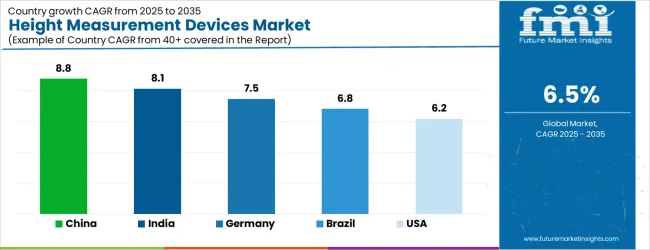
| Country | CAGR |
|---|---|
| China | 8.8% |
| India | 8.1% |
| Germany | 7.5% |
| Brazil | 6.8% |
| USA | 6.2% |
| UK | 5.5% |
| Japan | 4.9% |
The Height Measurement Devices Market is expected to register a CAGR of 6.5% during the forecast period, exhibiting varied country level momentum. China leads with the highest CAGR of 8.8%, followed by India at 8.1%. Developed markets such as Germany, France, and the UK continue to expand steadily, while the USA is likely to grow at consistent rates. Japan posts the lowest CAGR at 4.9%, yet still underscores a broadly positive trajectory for the global Height Measurement Devices Market. In 2024, Germany held a dominant revenue in the Western Europe market and is expected to grow with a CAGR of 7.5%. The USA Height Measurement Devices Market is estimated to be valued at USD 489.8 million in 2025 and is anticipated to reach a valuation of USD 489.8 million by 2035. Sales are projected to rise at a CAGR of 0.0% over the forecast period between 2025 and 2035. While Japan and South Korea markets are estimated to be valued at USD 67.8 million and USD 46.7 million respectively in 2025.
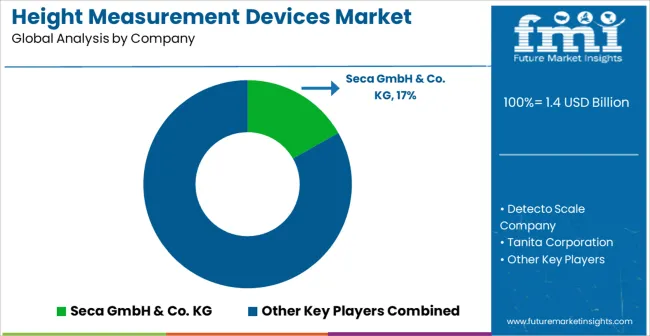
| Item | Value |
|---|---|
| Quantitative Units | USD 1.4 Billion |
| Product Type | Height Rod and Stadiometer |
| Technology | Digital Height Measurement Devices and Mechanical Height Measurement Devices |
| Age Group | Adult Height Measurement Devices and Pediatric Height Measurement Devices |
| End User | Hospitals, Clinics, and Others |
| Regions Covered | North America, Europe, Asia-Pacific, Latin America, Middle East & Africa |
| Country Covered | United States, Canada, Germany, France, United Kingdom, China, Japan, India, Brazil, South Africa |
| Key Companies Profiled | Seca GmbH & Co. KG, Detecto Scale Company, Tanita Corporation, Health o meter Professional, Charder Electronic Co., Ltd., ADE Germany GmbH, Marsden Weighing Group, Natus Medical Incorporated, InBody Co., Ltd., Befour, Inc., Doran Scales, Inc., KERN & SOHN GmbH, and A&D Company, Limited |
The global height measurement devices market is estimated to be valued at USD 1.4 billion in 2025.
The market size for the height measurement devices market is projected to reach USD 2.6 billion by 2035.
The height measurement devices market is expected to grow at a 6.5% CAGR between 2025 and 2035.
The key product types in height measurement devices market are height rod and stadiometer.
In terms of technology, digital height measurement devices segment to command 62.1% share in the height measurement devices market in 2025.






Our Research Products

The "Full Research Suite" delivers actionable market intel, deep dives on markets or technologies, so clients act faster, cut risk, and unlock growth.

The Leaderboard benchmarks and ranks top vendors, classifying them as Established Leaders, Leading Challengers, or Disruptors & Challengers.

Locates where complements amplify value and substitutes erode it, forecasting net impact by horizon

We deliver granular, decision-grade intel: market sizing, 5-year forecasts, pricing, adoption, usage, revenue, and operational KPIs—plus competitor tracking, regulation, and value chains—across 60 countries broadly.

Spot the shifts before they hit your P&L. We track inflection points, adoption curves, pricing moves, and ecosystem plays to show where demand is heading, why it is changing, and what to do next across high-growth markets and disruptive tech

Real-time reads of user behavior. We track shifting priorities, perceptions of today’s and next-gen services, and provider experience, then pace how fast tech moves from trial to adoption, blending buyer, consumer, and channel inputs with social signals (#WhySwitch, #UX).

Partner with our analyst team to build a custom report designed around your business priorities. From analysing market trends to assessing competitors or crafting bespoke datasets, we tailor insights to your needs.
Supplier Intelligence
Discovery & Profiling
Capacity & Footprint
Performance & Risk
Compliance & Governance
Commercial Readiness
Who Supplies Whom
Scorecards & Shortlists
Playbooks & Docs
Category Intelligence
Definition & Scope
Demand & Use Cases
Cost Drivers
Market Structure
Supply Chain Map
Trade & Policy
Operating Norms
Deliverables
Buyer Intelligence
Account Basics
Spend & Scope
Procurement Model
Vendor Requirements
Terms & Policies
Entry Strategy
Pain Points & Triggers
Outputs
Pricing Analysis
Benchmarks
Trends
Should-Cost
Indexation
Landed Cost
Commercial Terms
Deliverables
Brand Analysis
Positioning & Value Prop
Share & Presence
Customer Evidence
Go-to-Market
Digital & Reputation
Compliance & Trust
KPIs & Gaps
Outputs
Full Research Suite comprises of:
Market outlook & trends analysis
Interviews & case studies
Strategic recommendations
Vendor profiles & capabilities analysis
5-year forecasts
8 regions and 60+ country-level data splits
Market segment data splits
12 months of continuous data updates
DELIVERED AS:
PDF EXCEL ONLINE
Wound Measurement Devices Market
Respiratory Measurement Devices Market Size and Share Forecast Outlook 2025 to 2035
Digital Wound Measurement Devices Market is segmented by Diabetic Ulcer, Chronic Wounds, Burns from 2025 to 2035
Intra-Abdominal Pressure Measurement Devices Market Analysis - Size, Trends & Forecast 2025 to 2035
Measurement Technology in Downstream Processing Market Size and Share Forecast Outlook 2025 to 2035
Half Height Containers Market Size and Share Forecast Outlook 2025 to 2035
FBAR Devices Market
Laser Measurement Integrating Sphere Market Size and Share Forecast Outlook 2025 to 2035
Snare devices Market
C-Arms Devices Market Size and Share Forecast Outlook 2025 to 2035
Timing Devices Market Analysis - Size, Growth, & Forecast Outlook 2025 to 2035
Spinal Devices Market Size and Share Forecast Outlook 2025 to 2035
Phasor Measurement Unit Market Size and Share Forecast Outlook 2025 to 2035
Hearing Devices 3D Printing Market Size and Share Forecast Outlook 2025 to 2035
Medical Devices Market Size and Share Forecast Outlook 2025 to 2035
Network Devices Market Size and Share Forecast Outlook 2025 to 2035
Medical Devices Secondary Packaging Market Analysis by Material and Application Through 2035
Surface Measurement Equipment And Tools Market
Test and Measurement Equipment Market Size and Share Forecast Outlook 2025 to 2035
Hearable Devices Market Size and Share Forecast Outlook 2025 to 2035

Thank you!
You will receive an email from our Business Development Manager. Please be sure to check your SPAM/JUNK folder too.
Chat With
MaRIA